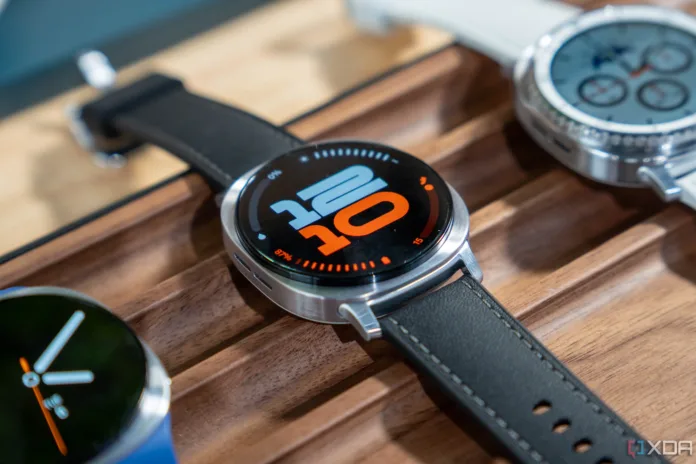The Article Tells The Story of:
- Samsung Cuts Support for 20mm Bands on Galaxy Watch 8
- New Dynamic Lug System Promises Better Fit—But at a Cost
- Users Must Replace Old Galaxy Watch Bands with New Models
- Heart Rate Tracking Improves, but Watch Band Loyalty Breaks
Table of Contents
Galaxy Watch 8 Breaks Compatibility with Old Straps
At Squaredtech.co, we’ve followed Galaxy Watch updates closely, and the latest change is a major one. Samsung has officially ended compatibility with its long-standing 20mm watch band standard. The newly released Galaxy Watch 8 and Galaxy Watch 8 Classic now use a Dynamic Lug System—a complete shift from the design used in earlier Galaxy smartwatches.
This move brings two major outcomes:
- A promised boost in heart rate tracking accuracy by 11%.
- Total incompatibility with your old Galaxy Watch bands—including third-party 20mm options.
Samsung says the new Dynamic Lug System improves how the watch sits on the wrist. It adjusts the band angle for a snugger fit, which helps the heart rate sensor stay in better contact with your skin. But to achieve this, the company ditched the universal 20mm strap slot that’s been used since the original Galaxy Watch.
From Squaredtech’s point of view, this is a big change for longtime users. If you’ve collected multiple bands over the years—whether for sports, style, or comfort—none of them will work with the Galaxy Watch 8. You’ll need to buy new straps specifically made for the Watch 8 series.
Read More About Our Article of Pebble Makes a Bold Comeback: A New Smartwatch Revolution in the Making Published on January 28th, 2025, SquaredTech
New Band System Improves Fit but Ends Strap Reuse
Samsung’s new Dynamic Lug System is one of the headline hardware features of the Galaxy Watch 8 and Watch 8 Classic. According to Samsung, this design:
- Reduces movement between the watch and your wrist.
- Makes band swaps easier.
- Improves health tracking accuracy.
The company reports an 11% improvement in heart rate tracking compared to the Galaxy Watch 7. This could be useful for athletes or users who rely on their smartwatch for fitness monitoring and health insights.
Still, the cost is clear: your old bands won’t connect to the new lugs. Samsung has moved away from the industry-standard 20mm pin system that allowed users to mix and match straps from any brand.
Until now, Galaxy Watch owners enjoyed a high level of flexibility. Even users upgrading from early models like the Galaxy Watch Active2 or Watch 4 could reuse their old 20mm bands. But with Watch 8, that continuity is gone.
Squaredtech.co sees this as a strategic decision—Samsung wants to push its own new strap ecosystem, similar to what Apple did with different case sizes and band types.
Users Must Buy New Straps for Galaxy Watch 8
If you’re upgrading to the Galaxy Watch 8 or Watch 8 Classic, be prepared to invest in new accessories. Samsung has launched a dedicated line of official bands for the new series, including:
- Athleisure Bands
- Fabric Bands
- Sport Bands
- Hybrid Bands (exclusive to Watch 8 Classic)
These bands are made to fit the new lug system and won’t be compatible with older Galaxy Watch models.
Unfortunately, no third-party 20mm bands will work either. That includes straps from brands like Spigen, Ringke, or budget options from Amazon and AliExpress. Every band must now be designed specifically for the Galaxy Watch 8 lug system.
For users with large collections of older straps, this change could be frustrating. Some may have invested in color-coordinated bands, luxury leather straps, or rugged sport bands—none of which are usable anymore.
As a representative from Squaredtech.co, we strongly recommend that Galaxy Watch 8 buyers factor in the extra cost of new straps when planning an upgrade. A typical Samsung official band can cost $30–$50, and most users will want more than one.
The Bigger Strategy Behind the Band Shift
At first glance, this looks like a minor design update. But Squaredtech believes Samsung’s switch to a new lug system is part of a larger strategy to control the accessory market.
By ending support for industry-standard bands, Samsung gains more control over:
- Band sales revenue
- Accessory compatibility
- Brand ecosystem exclusivity
Apple has long followed this path by offering exclusive bands and changing compatibility between case generations. Samsung appears to be doing the same with its Galaxy Watch lineup.
It’s a bold move—but also risky. If longtime users feel alienated, it could slow down Watch 8 adoption, especially for those with collections of old straps.
However, if the improved comfort and tracking performance live up to Samsung’s promises, the trade-off could be worth it for health-focused users.
From our testing and reporting at Squaredtech, we’ll be watching closely to see how consumers react and whether third-party accessory makers begin offering affordable alternatives for the new lug system.
Final Thoughts from Squaredtech.co
The Galaxy Watch 8 and Watch 8 Classic offer important upgrades in tracking accuracy and wearability. But those improvements come at a clear cost—band compatibility is gone.
If you’ve invested in older Galaxy Watch straps, they are now obsolete. The new Dynamic Lug System introduces a new era for Samsung wearables—one that leaves previous accessories behind.
While the change may improve performance, it also locks users into a new set of exclusive bands. For many, that means spending extra money just to maintain the personalization and flexibility they already had.
As always, Squaredtech recommends buyers carefully weigh the pros and cons before upgrading. If health tracking and improved ergonomics matter most, the Watch 8 offers clear benefits. But if you value accessory reuse and cost savings, this upgrade may be more frustrating than functional.
We’ll continue to follow user reviews, aftermarket accessory availability, and Samsung’s future band strategy in upcoming updates.
Stay with Squaredtech.co for the latest Galaxy Watch news, smart wearable trends, and smartwatch buying advice.
Stay Updated: Gadgets



Oh man, that sucks about the Galaxy Watch 8! I have a ton of 20mm straps, and now they’re useless? Guess I’ll be holding off on upgrading for a while.